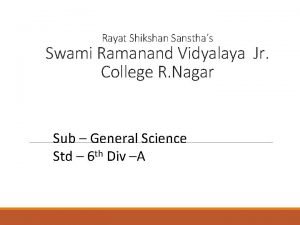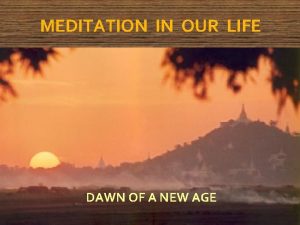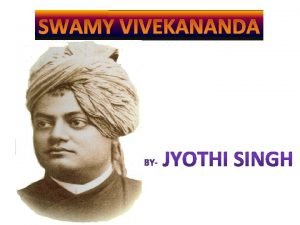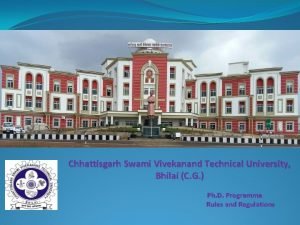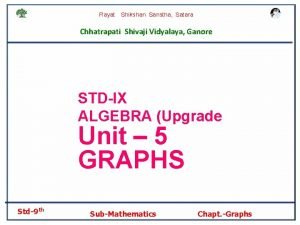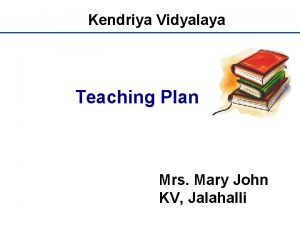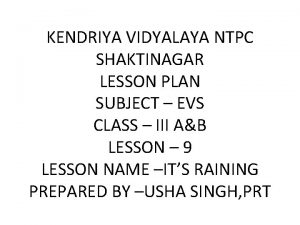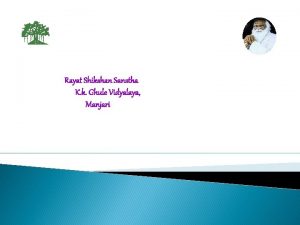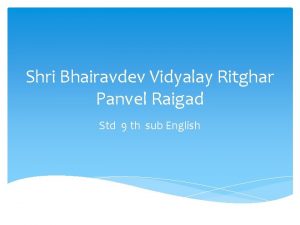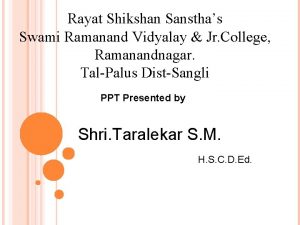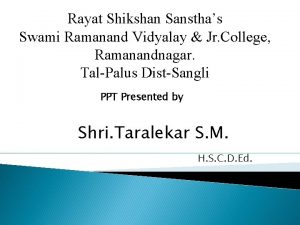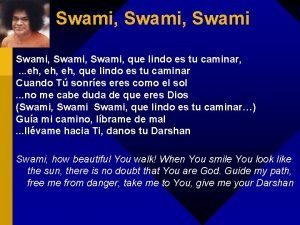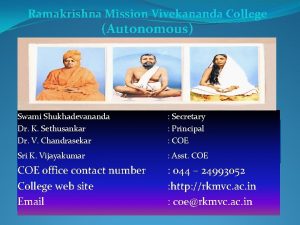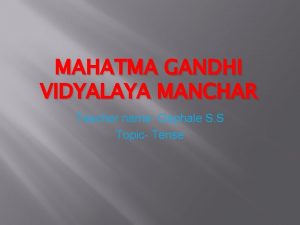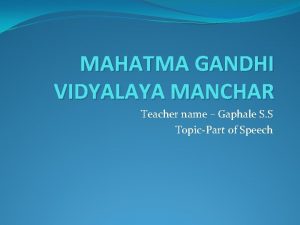INSPRINATION SWAMI RAMANAND VIDYALAYA JR COLLEGE RAMANANDNAGAR Teacher

















- Slides: 17

INSPRINATION

SWAMI RAMANAND VIDYALAYA & JR. COLLEGE RAMANANDNAGAR Teacher Name : - Miss. Lakule J. P.

SUB – ALGEBRA TH STD – 10

UNIT – PROBABILITY

3. SAMPLE SPACE : - THE SET OF ALL POSSIBLE OUTCOMES OF A RANDOM EXPERIMENT IS CALLED THE SAMPLE SPACE. A SAMPLE SPACE DENOTED BY S THE NUMBER OF ELEMENTS IN THE SET S IS DENOTED BY N(S). THE SAMPLE SPACE IS CALLED FINITE SAMPLE SPACE IF N(S) IS FINITE. EX. A DIE IS THROWN SAMPLE SPACE (S) = {1, 2, 3, 4, 5, 6} N(S) = 6 4. EVENT : - A SUBSET OF A SAMPLE SPACE IS CALLED AN EVENT AND IS DENOTED BY CAPITAL LETTERS A, B, C, …………X, Y, Z. THE NO. OF ELEMENTS IN THE EVENT SAY A, IS DENOTED BY N(A).

Sub Unit – 4. 1 Terms in probability 4. 2 Types of events 4. 3 Probability of an event 4. 4 Properties of probability

4. 1 Terms in Probability 1. Random Experiment : An experiment in which all the possible results are known in advance, but none of them can be predicted with certainty is called random experiment. Ex. 1) Tossing a Coin 2) Throwing a die 3) Drawing a card from a well shuffled pack of cards, etc. 2. Outcome : - The result of a random experiment is called an outcome. Ex. 1) Tossing a coin, we have to possible outcomes Head (H) or Tail (T) 2) Throwing a die We have six possible outcomes 1 or 2 or 3 or 4 or 5 or 6

4. 2 Types of events 1. Certain Event : - An event which contains all the sample points is called a certain event. Sample Space (S) is a subset of itself thus the sample space is a certain event. Ex. Throwing a die and getting a score from 1 to 6 is a certain event. 2. Impossible Event : - An event which does not contain any sample point is called an impossible Event. An impossible event is a null set it is denoted by Φ Ex. A coin is tossed getting 2 heads or two tails is an impossible event. 3. Elementary Event : - An event consisting of only one sample point of a sample space is called an elementary event. EX. Two coins are tossed simultaneously. If A is the event of getting two heads then A={ HH} ∴ n(A) = 1. Thus A is an elementary Event

4. Complement of an Event: Let A be an event in a sample space (S) then A is a subset of S. The set of all those sample points which are in S but not in A is called Complement of an Event and is denoted by A 'or Ac S A A´ EX. A die is thrown. A is the Event of getting an odd number. Then S = {1, 2, 3, 4, 5, 6} A = {1, 3, 5} ∴ A´ = {2, 4, 6} ∴ A´ is the complement of event A

S A B

Example – There are three red, three white , and three green balls in a bag. One ball is drawn at random from the bag i) P is the event that ball is red ii) Q is the event that ball is not green iii) R is the event that ball is red or white Solution : - Here, there are three red balls R 1, R 2, R 3, three white balls W 1, W 2, W 3 three green balls G 1, G 2, G 3 ∴ the sample space S = {R 1, R 2, R 3, W 1, W 2, W 3, G 1, G 2, G 3} ∴ n(S) = 9 (i) P is the Event that the ball is Red ∴ P = {R 1, R 2, R 3} ∴ n(P) = 3

(ii) Q is the event that the ball is not green ∴ Q = {R 1, R 2, R 3, W 1, W 2, W 3} ∴ n(Q) = 6. (iii) R is the Event that the ball is red or white ∴ R = {R 1, R 2, R 3, W 1, W 2, W 3} ∴ n(R) = 6. EXAMPLE A die is thrown (i) P is the event of getting an odd number. (ii) Q is the event of getting an even number. (iii) R is the Event of getting a prime number.



Example If two coins are tossed then find the probability of the events (i) Atleast one tail turns up. (ii) No head turns up. Solution : Let A be the sample space S = {HH, HT, TH, TT} ∴ n(S) = 4

(i) Let A be the event where atleast one tail turns up. then A = {HT, TH, TT} ∴ n(A) = 3

THANK YOU
 Swami ramanand vidyalaya ramanandnagar
Swami ramanand vidyalaya ramanandnagar Spoqr
Spoqr Prarthana dham samarpan meditation
Prarthana dham samarpan meditation Swami chart
Swami chart Swami ishwarananda
Swami ishwarananda Imperialism
Imperialism Swami vivekananda and tesla
Swami vivekananda and tesla Swami vivekanand institute of technology and management
Swami vivekanand institute of technology and management Chhatrapati shivaji vidyalaya
Chhatrapati shivaji vidyalaya Swachha vidyalaya puraskar.com
Swachha vidyalaya puraskar.com Sant tukaram vidyalaya dehu
Sant tukaram vidyalaya dehu Objectives of kgbv
Objectives of kgbv Lesson plan kvs bangalore region
Lesson plan kvs bangalore region Kvs lesson plan
Kvs lesson plan Kendriya vidyalaya mahasamund
Kendriya vidyalaya mahasamund Swach vidyalaya abhiyan
Swach vidyalaya abhiyan Maharaja sayajirao vidyalaya satara
Maharaja sayajirao vidyalaya satara Shri bhairavdev vidyalaya
Shri bhairavdev vidyalaya
